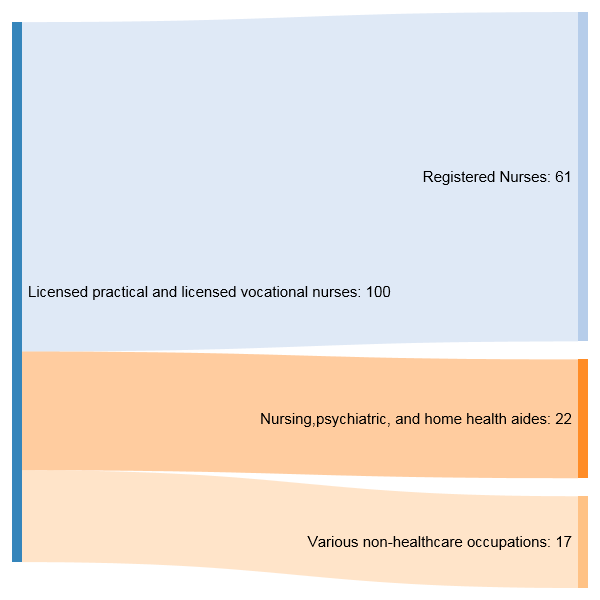What Data Visualization Tells Us about Career Progression
Many workers enter the workforce in low-level jobs and remain there for years, if not their entire working lives. Career pathway programs seek to change this by offering education, training and support services linked to occupations. Such programs aim to enable individuals to improve their skills, receive recognized credentials, and obtain better jobs with higher pay.
Abt has carried out several career pathways evaluations, most notably of the Pathways for Advancing Careers and Education (PACE) and Health Profession Opportunity Grants (HPOG) programs. The Administration on Children and Families, part of the U.S. Department of Health and Human Services, sponsors both programs and the Abt evaluations. The evaluations and our review of career pathways implementation and research for the U.S. Department of Labor have led to a key conclusion: to design career pathway programs, we need to understand better the career trajectories of workers in the wider job market who aren’t typically part of a program.
Worker Movement Between Jobs
Studies of career trajectories can shed light on transitions both into and out of occupations. Are new workers coming from other occupations at lower, higher, or approximately the same wages? When incumbent workers in a particular occupation leave that occupation, do they enter occupations at higher, lower, or approximately the same wages?
To facilitate Abt’s understanding of such transitions, we use a data visualization tool called a Sankey diagram. Figures 1 and 2 use Sankey diagrams to show the movement of a hypothetical group of 100 workers into and out of a single occupation – licensed practical nurse or licensed vocational nurse (LPN/LVN), a mid-level nursing occupation. Data for the diagrams comes from the Current Population Survey (CPS), a survey of households that tracks the industry and occupation of each survey respondent.

Movement into LPN/LVN jobs
Figure 1 shows the movement into the LPN/LVN occupation based on transitions found in the CPS between 2013 and 2014. Many of the people come from lower-level occupations, such as nursing, psychiatric, and home health aides (21) and personal care aides (6). We also see that many people come from higher-level occupations, such as registered nurse (17), and may be underemployed. Finally, we see that many (56) people come from other occupations. Movement from low-level healthcare occupations and some non-healthcare occupations is consistent with the types of occupational transitions intended by career pathway programs. However, it raises the question of how to prevent the underemployment we observe.

Movement out of LPN/LVN Jobs
Figure 2 shows the destinations of LPNs and LVNs after they leave that occupation. The largest group of workers goes on to become registered nurses (61 total). This type of transition is again consistent with the types of transitions intended by career pathways programs. The fact that this transition occurs naturally, in the absence of program interventions, suggests that it is realistic for career pathways participants. In contrast, as in Figure 1, we see some downward movement, such as transitions to nursing, psychiatric, and home health aides (22). This again raises questions about why such career regression occurs and how to prevent it.
Abt is studying occupational transitions as part of the Descriptive and Analytical Career Pathways Study for the U.S. Department of Labor. We plan to examine how occupational transitions relate to the industry, education, age, gender, race/ethnicity of workers and their geographical distribution. We hope to discover occupational transitions that constitute desirable advancement that career pathway programs haven’t yet extensively incorporated. We may also discover that some targeted transitions have less potential than assumed. The data on occupational transitions will come from the CPS, the National Longitudinal Survey of Youth (like the CPS, a federal survey) and through machine processing of worker resumes. The goal is that policymakers and practitioners who design and implement career pathway programs will use the data to improve program designs and outcomes for workers.
